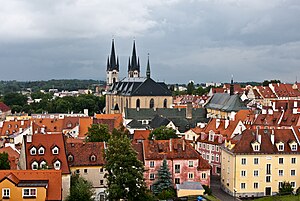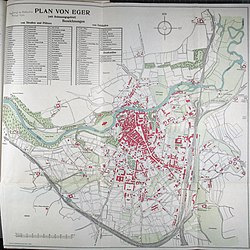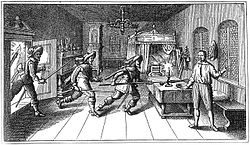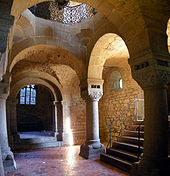Cheb
| Cheb | ||||
|---|---|---|---|---|
|
||||
| basic data | ||||
| State : |
|
|||
| Historical part of the country : | Bohemia | |||
| region : | Karlovarsky kraj | |||
| District : | Cheb | |||
| Area : | 9636.1106 ha | |||
| Geographical location : | 50° 5′ N , 12° 22′ E | |||
| Height: | 459 m nm | |||
| residents : | 31,920 (Jan 1, 2021) | |||
| Zip code : | 350 02 | |||
| License plate : | K | |||
| traffic | ||||
| Street: | R6 , E48 , E49 | |||
| railway connection: |
170 Cheb–Plzeň (–Prague) 179 Cheb–Nuremberg 140 Cheb–Chomutov 147 Cheb–Plauen |
|||
| Nearest international airport : | Letiště Cheb (Cheb Airport) ICAO: LKCB, IATA: – | |||
| structure | ||||
| Status: | city | |||
| Districts: | 19 | |||
| administration | ||||
| Mayor : | Antonín Jalovec (as of August 2019) | |||
| Address: | náměstí Krale Jiřího z Poděbrad 1/14 350 20 Cheb |
|||
| Municipality number: | 554481 | |||
| site : | www.mestocheb.cz | |||
| Location of Cheb in Cheb district | ||||
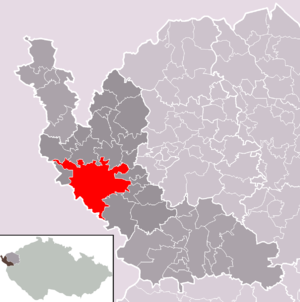
|
||||
Cheb [ ˈxɛp ] ( , German Eger ) is a town in the Karlovy Vary region in the westernmost part of the Czech Republic . With around 32,000 inhabitants, the city is an important location for education and industry.
In the High and Late Middle Ages Eger was an independent imperial city in the Holy Roman Empire , which is reflected in the city coat of arms.
geography
The city is situated on the Eger River in the Egerland , bordering Germany to the north and south-west , of which the city forms the historic center, some 42 km west-southwest of Karlovy Vary .
Eight kilometers northeast of the city is the Soos nature reserve near the village of Nový Drahov (Rohr), a peat and mineral meadow bog with carbon dioxide gas of volcanic origin escaping from mofettes . The Komorní hůrka (Kammerbühl) to the northeast of the city and the Železná hůrka (Eisenbühl) to the south on the Czech-Bavarian border, remnants of the two youngest Bohemian volcanoes , have also been designated as nature reserves . Goethe did research there.
There are two reservoirs near the town, on which water sports can be practiced: to the west, the Skalka dam , fed by the Eger, and to the south-east, the Jesenice dam , through which the Wondreb flows .
The 634-hectare Egerer Stadtwald lies directly across the border on German territory and is part of the market town of Bad Neualbenreuth .
Surname
The name of the city was Egire in 1061 . Eger and Cheb are documented from the 14th century , in 1374 even in the same text, "Egra in boemica lingua Cheb" ( German: "Egra, which is Cheb in Bohemian language " ). The Czech name can be traced back to an old form of ohyb (bend) and probably refers to the course of the river near the town. In addition, it is considered that Slavs would have taken over an originally Germanic name (chub) for a height or slope above the river.
In German, the city is named after the river Eger , on whose banks it lies. The name of the water has Indo-European roots: Agriā roughly means 'the strong, wild river'.
From 1850 the town was officially called Eger and Cheb. Since 1945 the official name is Cheb.
story
Early and High Middle Ages
Eger was first mentioned on February 13, 1061 as Egire . In 1125 the Margraves of the Bavarian North Gau , the Counts of Vohburg , built a castle on the site of an older Slavic complex. In 1167 Eger came into the possession of the Hohenstaufen Emperor Friedrich Barbarossa . Eger was elevated to the status of a town before 1179. King Frederick II signed the Gold Bull of Eger there on July 12, 1213 , which strengthened the legal status of the bishops of the empire and enlarged the Papal States. In 1242 Eger received Nuremberg city rights and in 1277 it became an imperial city . As a result of the Staufer family dying out in 1268, Eger came under Bohemian sovereignty for the first time a few years later. On October 4, 1322, with the city's consent , Ludwig the Bavarian pledged the city to the Bohemian King John for 20,000 silver marks . In a document dated October 23, 1322, the city of Eger was assured of extensive independence from the Kingdom of Bohemia , including the preservation of its position as an imperial city. However, this status was eroded in a long process and eventually lost. The Reich pawn was never cashed in, in the subsequent period of time the Reich pawn was spoken of in Cheb. After the crowns of the Kingdom of Bohemia and the Holy Roman Empire were united in one hand under Charles IV , the son of John, there was no longer any reason for redeeming the pledge. In the last years of his reign, Emperor Ludwig had definitely shown interest in redeeming it, but King John was reluctant. In 1350 there was a pogrom against the local Jews in Eger , during which the Jewish community was almost wiped out.
As an economically booming town, Eger had to deal with the impoverished landed gentry of the area, e.g. B. in the noble feud at the end of the 14th century. Offenses were documented in the Book of Afflictions and two Eight Books. On May 5, 1389, the peace of Eger between King Wenzel and a city league of southwest German imperial cities was closed during an imperial diet in Eger , after Wenzel had previously tried unsuccessfully to assert his interests against the cities.
Hussite Wars and Thirty Years' War
In the Hussite wars , the Catholic town of Eger took an active part on the side of the anti-Hussite coalition. She sent riot troops several times and took part in all the crusades against the Hussites . In June 1430, the city was in great danger when the Hussites passed Eger on their way back from Nuremberg to Bohemia. They destroyed part of the city walls in Obertorvorstadt, but were persuaded to withdraw by paying a large sum. Since the newly founded Jewish community had not taken part in the city's defense due to privileges , the city council complained to King Sigismund , who then expelled the Jews from the city; the displaced families were at least partially compensated. On April 25, 1459 the Cheb Treaty on the border between Bohemia and the Electorate of Saxony was signed in the town.
Eger later joined the Lutheran Reformation and came under massive pressure from Emperor Rudolf II. In 1609 the city was denied the freedom of religion granted to the Bohemian estates and in 1626 the Bohemian Counter-Reformation was also carried out in Eger.
During the Thirty Years' War , Albrecht von Wallenstein was murdered in Cheb on February 25, 1634 . In 1647 Cheb was besieged and taken by the Swedes . In order to regain the city, imperial troops under the Pilsen city commander Jan van der Croon blocked the Swedish occupation over the following winter. Due to the long starvation, this was about to give up when the Swedish General Königsmarck broke through the blockade in April 1648 and supplied the city with provisions. The Swedes finally left Cheb in 1649.
18th and 19th centuries
In 1723 Eger became a Free Royal City . In 1809 a great fire ravaged the northern part of the city. The medieval buildings destroyed in the process were not rebuilt. From the middle of the 19th century, Eger became the seat of the Eger Judicial District in the Eger District .
Until 1851 Franzensbad (Františkovy Lázně) belonged to the Municipality of Cheb. The mineral water from the Františkovy Lázně springs, which were originally called the Cheb Sauerbrunnen , received spa guests who were staying in Cheb at the time. In 1866, during the course of the German war , Eger became the target of the so-called “ locomotive flight ”, during which more than 140 Saxon locomotives and more than 1000 wagons were evacuated before the Prussian armed forces could get hold of them.
At the time of the Austrian Empire , Austrian geographers calculated the 939 meter high Tillen near Egers, directly on the border with Bavaria, as the geographical center of Europe and documented this on a copper plate on the summit (see Center of Europe on the Tillenberg ). However, according to more recent calculations, the center of Europe is north of Vilnius in Lithuania .
During the Imperial and Royal Monarchy, Eger was a garrison town. In 1914 the IV Battalion of the Infantry Regiment "Albrecht von Württemberg" No. 73 and the kk Landwehr Infantry Regiment "Eger" No. 6 were stationed there .
On October 21, 1918, the German members of the Austrian Reichsrat formed a German-Austrian national assembly. The founding of Czechoslovakia was proclaimed in Prague on October 28, 1918. On November 11, 1918, the dissolution of the Danube monarchy was complete with the withdrawal of Charles I from all government affairs. On December 16, 1918 at around 12:45 p.m., Eger was occupied by 500 men from the Czechoslovak 35th Infantry Regiment from Pilsen. The city surrendered only after the threat of artillery bombardment .
Czechoslovak Republic, Munich Agreement and Post-War Period
On March 3, 1919, one day before demonstrations were held on March 4, 1919 on the occasion of the elections taking place in Austria against belonging to Czechoslovakia , there was a popular uprising in Eger and a shootout with two dead. On October 1, 1933, Konrad Henlein founded the Sudeten German Home Front in Eger with the aim of "uniting all Germans" in the Czechoslovak Republic. The party had to be renamed the Sudeten German Party in 1935 and became the strongest grouping in the border area in the parliamentary elections of the same year.
With the Munich Agreement signed on September 30, 1938, Eger and the Sudetenland were ceded to the German Reich and occupied by German troops one day after the signing on October 1, 1938. On October 3, Adolf Hitler visited the now German city and was enthusiastically received by the population. During the pogroms that took place shortly thereafter in November 1938, the synagogue dating from 1893 was destroyed. On May 1, 1939, Eger separated from the district of Eger and formed its own urban district . At the same time, the municipality of Matzelbach was attached to it. Until 1945, the urban district of Eger belonged to the administrative district of Eger in the Reichsgau Sudetenland . The official seat of the district president was in Karlsbad .
On April 25, 1945, the US 97th Infantry Division began taking the city. The German troops put up little resistance and gradually retreated. On April 28, the city's airfield was also occupied, with 600 Wehrmacht soldiers surrendering. A little later, the city was handed over to Soviet troops due to the Potsdam Agreement .
After the end of the Second World War the city came under the administration of Czechoslovakia. Most of the German-Bohemian population was expelled in 1945/46 . The assets of German residents were confiscated by Beneš Decree 108 , the assets of the Evangelical Church were liquidated by Beneš Decree 131, and the city Catholic churches in Czechoslovakia were expropriated . Subsequently, many new citizens from central and southern Bohemia, Moravia, Czech repatriates , Slovaks and Roma moved to Cheb. Since then, these new citizens and their descendants have made up the majority of the population. In 1954, the city of Amberg in Germany took over the sponsorship of the expelled Sudeten Germans from the city and district of Eger. In the post-war years before German reunification in 1990, Cheb was a place for family reunions because of its geographical proximity to both German states.
present
Cheb has been a member of Friends in the Heart of Europe since 2002 . In January 2004 the documents of a twinning of the town of Cheb with the German town of Hof were signed. Friendly relations have also existed with the neighboring German towns of Waldsassen and Marktredwitz since the fall of the Iron Curtain . In the summer of 2006, Cheb and Marktredwitz organized the Boundless Garden Show 2006 Marktredwitz – Cheb/Eger . There is a Czech-German meeting center in the town. In 2009/10, the city led a legal dispute with Germany before the administrative court of Regensburg over a city forest on Bavarian territory.
The city was the administrative seat of the Okres Cheb until 2003 .
On September 11, 2010, the Cheb War Cemetery was inaugurated in Cheb in the presence of 3000 people with 5600 German dead, of which 473 were civilians.
demographics
| year | resident | Remarks |
|---|---|---|
| 1801 | 7,544 | in 764 houses (three suburbs) |
| 1830 | 9,500 | in 791 houses |
| 1845 | 10,459 | German-speaking residents, including an Israelite family |
| 1851 | 11,170 | |
| 1857 | 11.012 | on October 31st |
| 1870 | 13,565 | |
| 1877 | 15,000 | in 790 homes |
| 1900 | 23,582 | (with the garrison: 1,069 men) German residents |
| 1910 | 26,631 | thereof 22,979 Germans, 129 Czechs and 3,523 others |
| 1921 | 27,524 | thereof 23,125 Germans |
| 1930 | 31,546 | thereof 25,120 Germans, 3,496 Czechs and 2,930 others |
| 1939 | 31,672 | 2,808 of them Protestants, 28,264 Catholics, 20 other Christians and two Jews |
| 1945 | 45,000 |
| year | 1947 | 1990 | 2016 |
| resident | 14,533 | 29,962 | 32,355 |
city outline
The city of Cheb is divided into 19 cadastral districts and districts:
Districts / name of the cadastral district - if different
- Bříza (Pirk) / Bříza nad Ohří
- Cetnov _
- Dolni Dvory
- Dřenice (Treunitz) / Dřenice u Chebu
- Haje (Gehaag) / Haje u Chebu
- Horni Dvory
- Hradiště (Reichersdorf) / Hradiště u Chebu
- Hrozňatov (Kinsberg) / Starý Hrozňatov
- Cheb _
- Chvoječna (Sebenbach)
- Jindřichov (Honnersdorf) / Jindřichov u Tršnic
- Klest _
- Loužek (Au)
- Pelhřimov (Pilmersreuth) / Dolní Pelhřimov
- Podhoří (Kreuzenstein) / Podhoří u Chebu
- Podhrad (Pograth)
- Skalka (Stone) / Skalka u Chebu
- Střížov (Triesenhof) / Střížov u Chebu
- Tršnice _
Basic settlement units are Bříza, Cetnov, Dolní Dvory, Dřenice, Háje, Horní Dvory, Hradiště-průmyslový obvod, Hrozňatov, Cheb-historické jádro I, Cheb-historické jádro II, Chvoječná, Jesenická přehrada, Jindřichov, Klášterní Klest, hof) , (Köstel Komorní Dvůr (Kammerhof) , Loužek, Maškov (Matzelbach) , Na Vyhlídce, Nádraží, Nádrž Skalka, Pelhřimov, Pod Horní branou, Pod Chlumečkem, Podhoří, Podhrad, Podhrad-východ, Sídliště Zlatý vrch, Skalka, Slapřov ( Schloppenhof) , Svatý Kříž (Holy Cross) , Tršnice, U Horní brány, U Hradiště, U Lodní brány, U nádraží, U nemocnice, U stadiónu, U Zátiší, Za klášterem, Za nádražím, Zahrádky, Zátiší-Myslivna and Zlatý vrch.
town twinning
-
 Hof , Germany
Hof , Germany
-
 Tharandt , Germany
Tharandt , Germany
-
 Nizhny Tagil , Russia
Nizhny Tagil , Russia
-
 Rheden , Netherlands
Rheden , Netherlands
-
 Bec Ninh , Vietnam
Bec Ninh , Vietnam

Culture and sights
The historic city center was declared a municipal monument reserve in 1981 .
imperial castle
In addition to the Black Tower and part of the eastern ramparts, the Romanesque double chapel from the years 1179 to 1188 has been preserved from the Imperial Castle of Eger , which was built in the second half of the 12th century . An octagonal opening connects the floors. The upper floor has a ribbed vault over four polygonal columns. Many components are provided with sculptural decoration. There is a Staufer stele in front of the entrance to the Kaiserburg . She was unveiled on July 12, 2013, the 800th anniversary of the Gold Bull of Eger .
churches and monasteries
The Gothic Franciscan church with monastery and cloister was consecrated in 1285 with the participation of Rudolf I. after a previous building burned down in the town fire in 1270. However, the high tower that can be seen from afar was not added to the south side of the choir until the 14th century. The cloister features a 15th-century painted vault. Overall, the church, monastery and cloister are among the most beautiful and best-preserved buildings in the south-west of the town centre, but the interior decorations, with the exception of the monastery library, fell into disrepair in the second half of the 20th century.
The former Klarakirche of the Klarissenorden opposite was built from 1708 to 1711 according to a plan by Christoph Dientzenhofer . It is one of the most valuable baroque buildings in the city. The church has been profaned and is used as a concert venue.
The Church of St. Nicholas (Kostel svatého Mikuláše) was built in the 13th century as a three-nave basilica . Of these, the western portal and the lower part of the tower have been preserved. The three-aisled nave, the presbytery and the sacristy date from the Gothic period. After the fire in 1742, two towers with baroque domes were rebuilt according to a design by the local master builder Balthasar Neumann . After a fire in 1809, the church received a historicist interior in the neo -Gothic style (altar, choir stalls and organ). During a US air raid on April 20, 1945, the Balthasar Neumann church towers burned down.
In the city center is the Gothic Bartholomew 's Church .
marketplace
On the market square, the layout of which dates back to the 13th century, in addition to the baroque town hall by the Italian architect Giovanni Battista Alliprandi , which was unfinished due to lack of funds, and many other buildings steeped in history, there is also a group of houses that essentially go back to the late Gothic period, the so-called Egerer Stöckl (Špalíček). This landmark of the marketplace is a complex of eleven bizarre half-timbered houses in which Jewish merchants lived. According to the oldest description from 1472, there were originally three such blocks of houses, the floor plan of the other two blocks can be traced to this day, but the dilapidated building structure was not preserved during the restoration work in the 1960s. There are two market fountains in the square, one with a statue of Hercules and the other with a statue of Roland .
The Grüner house on the market square belonged to the Werndl family, whose family coat of arms is attached above the portal . Johann Wolfgang von Goethe often stayed in this house .
museum
The Cheb Museum is located in the 15th-century Gothic town house (Pachelbelhaus) where Wallenstein was murdered on February 25, 1634. In addition to Wallenstein's death room and a number of reminiscences of Friedlander (e.g. his horse shot dead in 1632, saddle, riding shoes and the partisan with which he was stabbed), the museum contains a picture gallery of his family and numerous antiques from bourgeois private ownership, including a secretary from the 18th century and Biedermeier furniture, sacred Gothic and Baroque sculptures, panel paintings, ceramics and viewing glass from Franzensbad. The most valuable exhibit is the Cheb Antependium , a Romanesque embroidery from the former Poor Clares Convent. The museum also includes documentation on the 20 border villages in Egerland that were abandoned after 1945 as a result of the expulsion.
parks
- Recreation area Krajinka on the left bank of the Ohře. In the course of the Cheb Nature and History garden show in 2013, the areas below the castle were redesigned.
More Attractions
- Bismarck Tower from 1909, southwest of the city
- Cheb railway station and Eger viaduct
- Cemetery Cheb
- stone house
- Covered bridge over the Eger
- The numerous half-timbered houses in the border villages are remarkable in the Cheb area .
- The early baroque pilgrimage church of Maria Loreto in Starý Hrozňatov (Altkinsberg) including the castle is located five kilometers south of Cheb.
- Schiller house
- pachelbel house
- Limbeck house
Regular events
- Every two years, on the last weekend in June, the city hosts the International Festival of Youth Wind Orchestras (FIJO).
Economy and Infrastructure
traffic
road traffic
Cheb is connected to the Czech expressway network via the R6 expressway to Prague . The German federal states of Bavaria and Saxony can be reached on federal roads via the European routes E48 (Bayreuth-Prague) and E49 (Magdeburg-Vienna) and a total of five road border crossings .
rail transport
Cheb railway station is a regional railway junction. Originally it was built between the lines of the Actiengesellschaft der Bayerischen Ostbahnen , the Royal Bavarian State Railways and the Voigtland State Railway and operated by the Egerer Bahnhofsgemeinschaft, which existed until the Second World War. The German Reichsbahn took over the Bavarian and Saxon shares. The station was also used by German express trains in domestic traffic, which shortened the route through Czechoslovakian territory in order to be able to offer transfer connections to the nearby seaside resorts. After the Second World War, the Czechoslovak State Railways took over the station, which is still an important border crossing to Bavaria and Saxony. There are currently direct connections from Nuremberg with fast Regional Express tilting trains operated by DB Regio AG . The Oberpfalzbahn runs from Marktredwitz and serves all stops between Marktredwitz and Cheb. In Cheb stops the SC Pendolino line Bohumín - Ostrava - Prague - Pilsen - Františkovy Lázně; there are other direct connections to Nuremberg and Plauen in Germany.
railway lines
- No. 170 Cheb–Plzeň (–Prague)
- No. 179 Cheb-Marktredwitz-Nuremberg
- No. 140 Cheb–Karlovy Vary–Chomutov
- No. 147 (Cheb–)Františkovy Lázně–Plauen
- No. 146 Cheb–Luby u Chebu
- No. 148 Cheb–Hranice v Čechách
air traffic
Cheb Airport (ICAO: LKCB, IATA: -) is the oldest airport in the Czech Republic. It was built in 1918. Since 2010 it has been reopened for civil domestic flights.
educational institutions
Cheb is the location of the Faculty of Economics of the University of West Bohemia in Pilsen .
personalities
literature
in reverse order of appearance
- Jaromír Boháč, Jiří Strádal: Cheb (Eger) in the mirror of the time. Město Cheb, Cheb 2003 (German, English, Czech).
- Heimatkreis Eger - history of a German landscape in documentation and memories. Publisher: Egerer Landtag eV Heimatverband für Eger, Stadt und Land with extensive articles on the development of the city of Eger, descriptions of places in the surrounding Egerland, and with map overviews in the appendix, pages 1 to 568, Amberg in der Oberpfalz 1981.
- Eger (encyclopedia entry). In: Meyers Great Conversation Lexicon. 6th edition, volume 5, Leipzig and Vienna 1906, p. 388 .
- Vinzenz Prockl: Eger and the Egerland . 2nd edition, Falkenau 1877 ( digital copy ).
- P. Drivok: Older history of the German imperial city of Eger and the Reich area of Egerland. Shown in their interrelationships with the neighboring German states and Bohemia using documentary material . Moritz Schäfer, Leipzig 1875 ( digital copy ).
- Franz Kürschner: On the history of the siege of Eger by the Swedes in 1647 . In: Communications of the Association for the History of Germans in Bohemia . Volume 11, Prague 1873, pp. 27–31.
- B. Dabik: Chronicle of the Teutonic Order Priest Coming to Eger in 1580 . In: Announcements of the Association for the History of the Germans in Bohemia , Volume 9, Prague 1871, pp. 65–80 .
- Joseph Sebastian Grüner : Contributions to the history of the royal. City of Eger and the Eger area. From documents. JG Calve, Prague 1843 ( digital copy ). ( review ).
- Anton Grassold: Description of the old castle in Eger in Google book search, Eger: Kobetsch 1831.
web links
itemizations
- ↑ http://www.uir.cz/obec/554481/Cheb
- ↑ Český statistický úřad – Population figures for Czech municipalities as of January 1, 2021 (PDF; 349 kB)
- ↑ Antonín Profous : Místní jména v Čechách : Jejich vznik, původ, význam a změny. Vol. II., CH-L. Česká akademie věd a umění, Prague 1949.
- ↑ a b Karlheinz Hengst : Why is the river Eger called Ohře in Czech and the city Cheb? In: Erzgebirge Heimatblatt 35(2013)1, ISSN 0232-6078 , pp. 3-5.
- ↑ Bernhard Grueber : The Imperial Castle of Eger and the monuments adjoining this building. Prague and Leipzig 1864 ( digital copy at Google Books); ders.: The Black Tower on the Imperial Castle in Eger. (With illustration.) In: Communications of the Association for the History of the Germans in Bohemia , No. 4, Prague 1863, pp. 2-8 ( digitalisate at Google Books).
- ↑ Ernst Theodor Gaupp : German city rights of the Middle Ages, with legal-historical explanations . Volume I: The municipal rights of Strasbourg, Haguenau, Molsheim, Colmar, Annweiler, Winterthur, Landshut in Bavaria, Regensburg, Nuremberg, Eger, Eisenach and Altenburg . Breslau 1851, pp. 182–193 .
- ↑ Johann Theodor Benjamin Helfrecht : Ruins, antiquities and castles still standing on and on the Fichtelgebirge. One try. Hof 1795, p. 181 ff.
- ↑ https://www.bohemia-online.de/index.php/bohemia/article/viewFile/2372/3635
- ↑ Franz Kürschner: On the history of the siege of Eger by the Swedes in 1647 . In: Communications of the Association for the History of Germans in Bohemia . Volume 11, Prague 1873, pp. 27–31.
- ↑ Ernst Höfer: The End of the Thirty Years' War. strategy and war. Böhlau, Cologne/Weimar/Vienna 1997, ISBN 3-412-04297-8 . pp. 95-96, 171-172.
- ↑ http://encyklopedie.cheb.cz/en/casova-osa
- ↑ Chronicle of the US 97th Infantry Division
- ↑ Czech Republic News: Lawsuit against Germany. Prague newspaper. Retrieved November 17, 2009
- ↑ Max Hägler: Stadtwald von Eger - The time of the Cold War is over. In: sueddeutsche.de . December 4, 2010, retrieved September 22, 2015 .
- ↑ Martin Dodenhoeft: And why are you here? Conversations at the war cemetery in Cheb. Voice and Way 4/2010, pp. 10–11 ( German War Graves Commission ).
- ↑ Wolfgang Jäger: Geographical-historical-statistical newspaper encyclopedia . Volume 1: A - H , Nuremberg 1805, p. 625 .
- ^ Yearbooks of the Bohemian Museum of Natural History, Regional Studies, History, Art and Literature . Volume 2, Prague 1831, p. 199 .
- ↑ Johann Gottfried Sommer : The Kingdom of Bohemia . Volume 15: Elbow Circle , Prague 1847, p. 303 .
- ↑ Hermann Wagener (ed.): State and Society Encyclopedia . Volume 6, Berlin 1861, p. 644 .
- ↑ Statistical overviews of the population and livestock in Austria . Vienna 1859, p. 39, right column .
- ↑ Georg Habermann: local history for the schools of the Cheb district . Eger 1875, p. 39 .
- ↑ Vinzenz Prockl: Eger and the Egerland presented historically, statistically and topographically . 2nd edition, volume 2, Falkenau 1877, p. 204 .
- ↑ Meyer's Great Conversation Lexicon . 6th edition, volume 5, Leipzig and Vienna 1906, p. 388 .
- ↑ a b c Ernst Pfohl: Ortslexikon Sudetenland. Page 124. Helmut Preußler Verlag-Nuremberg.1987. ISBN 3-925362-47-9
- ^ a b c Rudolf Hemmerle : Sudetenland Encyclopedia . Publisher: Adam Kraft Verlag. 2nd Edition. tape 4 , 1985, ISBN 3-8083-1163-0 , pp 124 .
- ↑ a b c Josef Hemmerle , Edgar Pscheidt and others: Eger, formerly a free imperial city. Amberg 1986, p. 132 (catalogue of the exhibition of the German National Museum in Nuremberg, the Munich City Archive and the Sudeten German Archive in Munich).
- ↑ a b Michael Rademacher: German administrative history from the unification of the Reich in 1871 to the reunification in 1990. sud_eger.html#stadtkreis. (Online material for the dissertation, Osnabrück 2006).
- ↑ http://www.uir.cz/katastralni-uzemi-obec/554481/Obec-Cheb
- ↑ http://www.uir.cz/casti-obce-obec/554481/Obec-Cheb
- ↑ http://www.uir.cz/zsj-obec/554481/Obec-Cheb
-
↑ Susanne Sodan: New splendor for Sidonie's castle , Sächsische Zeitung, Freital, August 30, 2013, p. 8 and
New splendor for the castle of the king's daughter Sidonie , Freie Presse, Freiberg, August 30, 2013, p. 10. - ↑ Partnerska mesta. (Twin Cities). City of Cheb (cz).
- ↑ Stauferstele Cheb on stauferstelen.net with historical background information. Retrieved March 22, 2014.
- ↑ Fijo 2018


